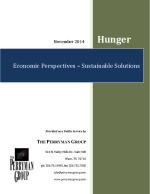Hunger
Economic Perspectives ‑ Sustainable Solutions
Published on November 06, 2014

Even beyond the obvious physical and mental costs of food insecurity and the incalculable toll on the stability and dignity of families across the United States, there is also a tremendous economic cost. Health care needs of people who are food insecure are higher due to increased incidence and severity of disease. Health outcomes are also worse, reducing productivity and lifetime earnings. In addition, education expenses are higher, with a greater need for intervention such as special education. Achievement levels (and, hence, lifetime earnings) are negatively affected. These costs multiply as they work their way through the business complex and are largely borne by the whole of society. The Perryman Group estimates that hunger costs the US economy $461.9 billion in total expenditures and $221.9 billion in gross product each year as well as nearly 2.5 million permanent jobs on an ongoing basis.
On an incidence basis, the lifetime costs associated with hunger at current levels are almost $3.4 trillion in aggregate spending, over $1.5 trillion in gross product, and 15.9 million person-years of employment.
We have estimated that every $1.00 invested in expanding the food bank network to meet current needs will result in $33.27 in incremental spending, $15.82 in additional gross product, and $10.31 in personal income (including related multiplier effects).
"Unlike many social problems, hunger involves a relatively simple answer," said Dr. Ray Perryman, President and CEO of The Perryman Group. "If people are provided food, the problem is solved. While the underlying causes certainly need to be addressed, the major harms can be avoided in a straightforward manner."
The Perryman Group estimates that the incremental benefits of expanding food bank and charitable food distribution networks enough to meet current food insecurity needs include $556.6 billion in yearly spending, $264.7 billion in annual gross product, and almost 3.1 million ongoing jobs in the United States.
"Tens of millions of Americans do not have enough food to meet basic daily needs, which is nothing short of tragic," said Dr. Perryman. "Every year that this problem is allowed to persist literally saps trillions of dollars in long-term economic potential from the United States."
For more information, please refer to the following resources:
- Report (PDF)
- [Infographic] Hunger: The Economic Effects and the Possibility of a Solution (www.perrymangroup.com)
- Tags: hunger, food, healthcare